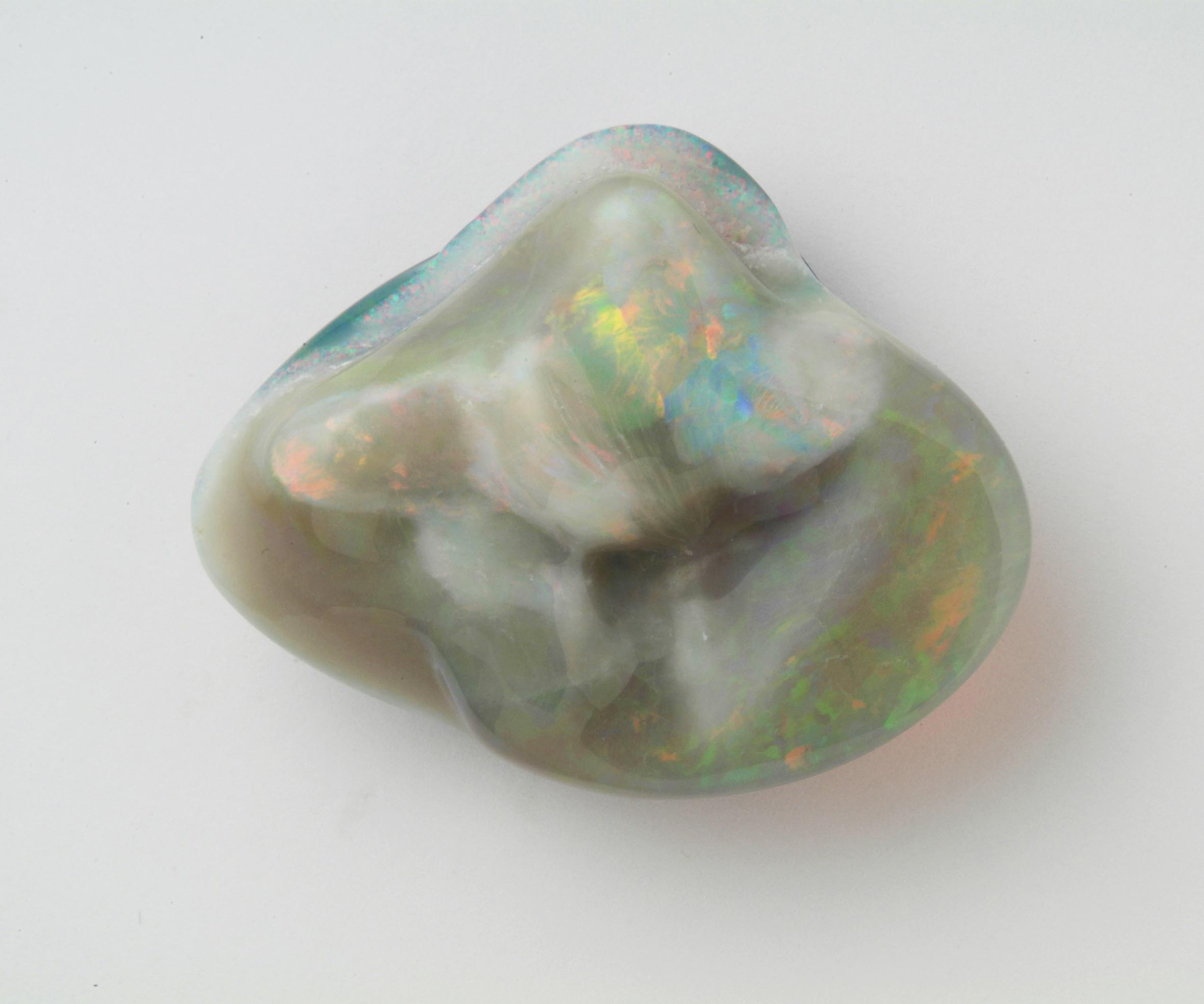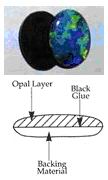|
 |
 |
 |
 |
|
|
|
|
|
|
|
|

|
 |
|
甚麼是歐泊石? What's Opal? |

|
| Chemistry |
Crystal System |
Hardness |
| Cleavage |
Fracture |
Specific Gravity |
| None |
Conchoidal |
Variable (1.8 - 2.3) |
| Color, Transparency
& Lustre
|
Conchoidal |
Transparent to milky white appearing in white, grey, red, brown, blue, green & black.
Lustre: Most Opal has a vitreous (glass-like) or pearly finish, but some are resinous or dull.
|
Common Opal: Translucent, pale in various colors, but lacks the reflective colors of precious Opal.
Precious Opal: Milky white or black in color with reflections of brilliant colors such as, blues, reds & yellows.
Fire Opal: Red and yellow colors are dormant which create flame-like reflections.
Hyalite: Has no color.
Hydrophane: Becomes transparent when placed in water.
Wood Opal: Is wood that has been partially replaced by Opal silica.
|
 歐泊石 OPAL 歐泊石 OPAL
Opal is a form of silica, chemically similar to quartz, but containing water within the mineral structure. Precious opal generally contains 6-10% water and consists of small silica spheres arranged in a regular pattern.
Opal occurs in many varieties, two of which are precious opal and potch.
Colour in precious opal is caused by the regular array of silica spheres and voids diffracting white light, and breaking it up into the colours of the spectrum. The diameter and spacing of the spheres controls the colour range of an opal.
Small spheres (approx. 150-200 nm; I nm = 1 0'9 m) produce opal of blue colour only, whereas larger spheres (350 nm) produce red colour. Opal with red colour can display the entire spectrum.
Opal colours also depend on the angle of light incidence and can change or disappear when the gem is rotated.
In potch opal, the silica spheres may be absent or too small or irregularly arranged to produce colour.
那種引誘人們從舒適的城市到澳大利亞的窮鄉僻壤去采歐泊石的狂熱,象慢性疾病一樣長久不衰——並且人們一直沒有從中解脫出來。歐泊石礦工,是那種既迷戀于寶石閃爍著的五彩繽紛的顏色,又寂寞寡言的人。他們的生活常常是貧困交加。他們忍受著嚴寒、酷暑、補給的不充分以及工具的簡陋。
是什麼促使人們在這樣的條件下去尋找歐泊石呢?為什麼很多人認為歐泊石是所有寶石中最漂亮和最有吸引力的呢?答案在於它的美麗是獨一無二的這樣一個事實。
歐泊石的種類: TYPES OF OPAL: |

|
 Black and Semi Black Opal:
Black and Semi Black Opal:
Typically found in Lighting Ridge, New South Wales, a black opal is distinguishable through its dark grey or black base colour. This naturally dark backing works to enhance the brilliance of the diffracted opal colours. A black opal’s rarity and depth of colour makes it the most valuable and sought after opal: the sharper and brighter the colour of black opal, the higher its value.
|
 White Opal:
White Opal:
White opal has been found in many locations worldwide and has been highly prized for many centuries. Australian white opal is by far the best the world has to offer and is it any wonder with red, blue, green, purple and all the other colors of the rainbow available.
|
 Boulder Opal:
Boulder Opal:
Formed on an ironstone based rock, boulder opal is found mostly in Queensland. Similar to black opal, Boulder opal possesses a darker base colour enhancing the opals brilliance. The opal occurs as a thin uneven layer naturally adhering to the ironstone, which often protrudes to the surface when cut. Depending on how boulder opal is polished it can be very smooth and glossy or quite rough, and is often cut in irregular shapes adding to its uniqueness. In terms of value, Boulder opal which has a full face of diffracted brilliant colours is often prized above ‘matrix’ opal which possesses ironstone intrusions.
|
 Doublet Opal:
Doublet Opal:
Doublets are made by laminating a thin slice of colourful Light Opal, to a layer of dark material (either opal potch or a slice of boulder). The dark backing enhances the opals natural colours giving the effect of high quality black opal. Generally, doublets require less opal material and therefore are available at a lower cost.
|
 Triplet opal:
Triplet opal:
Triplets are made by attaching an even finer slice of opal to a dark base and then adding a crystal cap for protection. Triplets can range from souvenir quality to gem quality, with the best specimens showing the brilliant colours of fine black opal. Only a thin slice of opal material is used in the creation of triplet opal, hence the cost is generally more attractive than a doublet, or a solid black opal. Typically both varieties are water sensitive and hence stones should not be immersed. However, Opal Strike offers our customers and wholesalers a range of high quality loose triplets guaranteed not to lift apart. An opal is a stone you will treasure forever.
|
 Synthetic Opal:
Synthetic Opal:
Synthetic opal, such as Gilson, is opaline silica produced in the laboratory and having a similar structure to that of precious opal. The following observations can help to differentiate between natural and synthetic opal:
- synthetic stones generally show brighter colours, and colour patches are often larger than in natural opal
- colour grain boundaries are generally highly irregular in synthetic opal
- within each colour grain in synthetic opal there are numerous sub-grains that produce a distinctive snakeskin pattern
- synthetic material generally shows a more ordered array of colours since artificial material does not duplicate the intricate pattern of natural opal.
|
| | |
 |
 |
| | | | |